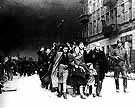 Warsaw Ghetto Uprising
Warsaw Ghetto Uprising
Irena Kleppfisch, a child survivor of the Holocaust, is an important writer whose best known works include a poem called "Bashert." Its title, a Yiddish word, evokes senses of inevitability and fate. As it grieves and protests, "Bashert" does not mention the Holocaust directly, but that event shadows every line: "These words are dedicated to those who died....These words are dedicated to those who survived." Kleppfisch's father, Michael, was one of those who died. Israel Gutman, survivor and historian of the Warsaw Ghetto uprising, says that Michael Kleppfisch, "who played an important role in the manufacture of armaments in the ghetto," was killed on April 20, 1943. He died in hand-to-hand fighting against Brigadier General Jürgen Stroop's German forces, who had been directed to liquidate the ghetto. In the summer of 1942, the Nazis removed 300,000 Jews from the Warsaw Ghetto. Most were sent to their deaths in Treblinka's gas chambers. Michael Kleppfisch and Gutman were members of a group of young Jewish men and women--they numbered 700 to 750--who trained and armed themselves as best as they could. They were determined to resist Nazi efforts to destroy the nearly 60,000 Jews who remained in the ghetto in the early spring of 1943. In January of that year, SS chief Heinrich Himmler had ordered further deportations, but Jewish resistance impeded that effort. Aware that they would meet determined resistance, the Germans regrouped and returned on Monday, April 19, the eve of Passover, to finish the job. What ensued was, in Gutman's words, "the first urban uprising in German-occupied Europe, and, among the Jewish uprisings, the one that lasted the longest, from April 19 to May 16, 1943." The poorly armed Jewish fighters, who also lacked military training and battle experience, were outnumbered three-to-one by Nazi forces, who had tanks and cannons. The Jews' "arsenal" consisted mainly of pistols, Molotov cocktails, and a few rifles, which had been smuggled into the ghetto or looted from Germans who were ambushed in January's resistance. Using hit-and-run tactics and taking advantage of bunker hiding places, the Jewish fighters kept the Nazis off balance during the uprising's early days. However, the Germans retaliated by burning the ghetto, building by building. Even then, Jewish resistance continued--doomed though it was. Not until May 8 did the Germans destroy the Jewish Fighting Organization's headquarters bunker at 18 Mila Street, a struggle in which Mordecai Anielewicz, the organization's commander, perished. On May 16 Stroop declared victory, proclaiming that "the Jewish quarter of Warsaw no longer exists." The losses the Jewish fighters had inflicted on the Germans were militarily small--Stroop's report noted 16 dead and 85 wounded--but the Warsaw Ghetto uprising remains an immensely important example of heroic Jewish resistance against overwhelming odds.
Photo: Bildarchiv Preussischer Kulturbesitz
|
